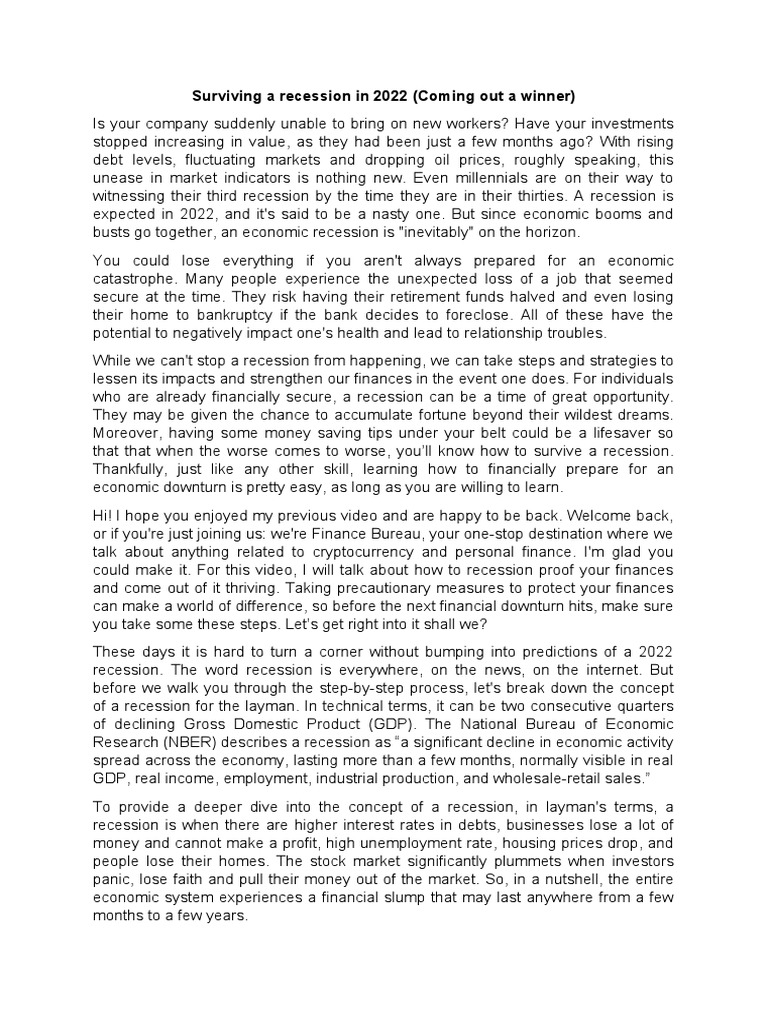Analyzing Uber's Resilience: Will The Stock Survive A Recession?

Table of Contents
Uber's Revenue Streams and Recessionary Vulnerability
Impact of Reduced Consumer Spending
During recessions, discretionary spending—expenditures on non-essential goods and services—typically declines significantly. This directly impacts Uber's core businesses: ride-sharing and food delivery.
- Decreased ridership: As people cut back on leisure activities and prioritize essential expenses, the demand for ride-hailing services like UberX and Uber Black is likely to decrease.
- Potential price sensitivity: Consumers become more price-conscious during economic downturns, potentially leading to a shift towards cheaper transportation options or increased price sensitivity to Uber's services.
- Impact on Uber Eats orders: While food delivery often shows some resilience, even essential spending is reduced during a severe recession. Consumers might opt for cheaper home-cooked meals instead of ordering through Uber Eats.
Historical data from previous recessions shows a clear correlation between economic downturns and reduced spending on ride-sharing and food delivery. For example, during the 2008 financial crisis, ride-sharing was a nascent industry; however, data from similar transportation services showed significant declines in ridership. Uber's current market share and competitive landscape will also influence its ability to withstand this pressure, with competition from Lyft and other localized services posing an ongoing challenge.
Diversification and Resilience Factors
Uber's diversification efforts, however, present a potential buffer against recessionary pressures. Its expansion into Uber Freight, offering logistics and transportation services to businesses, adds a layer of resilience.
- Growth potential of Uber Freight: The demand for freight transportation tends to be less sensitive to economic fluctuations than consumer spending on ride-hailing or food delivery. Businesses may even increase their reliance on efficient freight services during economic uncertainty to optimize supply chains.
- Potential for increased demand in freight during a recession: Companies might opt to reduce their warehousing costs by using just-in-time delivery solutions provided by Uber Freight.
The relative resilience of different revenue streams is crucial. While ride-sharing and food delivery might experience downturns, the growth potential of Uber Freight could help offset these losses, enhancing the company's overall resilience. Furthermore, Uber's ongoing cost-cutting measures and efficiency improvements play a significant role in navigating economic uncertainty.
Financial Health and Debt Levels
Analyzing Uber's Balance Sheet
A strong financial position is crucial during economic downturns. Analyzing Uber's balance sheet reveals key indicators of its resilience:
- Debt-to-equity ratio: A lower ratio indicates lower financial risk. Analyzing this ratio over time provides insight into Uber’s financial management.
- Free cash flow: Positive free cash flow demonstrates the ability to generate cash after covering operating expenses and capital expenditures, providing a financial cushion.
- Operating margins: Improved operating margins suggest increased efficiency and profitability.
Comparing Uber's financial health to competitors like Lyft provides valuable context. The impact of interest rate hikes on Uber's debt servicing costs is another critical factor influencing its financial resilience.
Investor Sentiment and Stock Price Volatility
Investor sentiment significantly impacts Uber's stock price. Understanding current trends is vital:
- Stock price trends: Analyzing historical stock price performance and identifying patterns offers insights into market sentiment towards Uber.
- Analyst ratings: Following analyst ratings and recommendations helps gauge the overall view of Uber's potential.
- News sentiment: Tracking news articles and social media mentions related to Uber can highlight potential risks and opportunities influencing investor perception.
Short-selling activity, where investors bet against a stock's price, can amplify stock price volatility during uncertain times. Monitoring this activity provides a further indication of investor confidence in Uber.
Strategic Adaptations and Future Outlook
Pricing Strategies and Demand Management
Uber's ability to adjust its pricing strategies will be crucial during a recession:
- Dynamic pricing: Uber's existing dynamic pricing model allows for flexibility, adjusting prices based on demand. This could help maintain profitability even during periods of reduced demand.
- Promotions and loyalty programs: Targeted promotions and loyalty programs can attract price-sensitive customers and incentivize repeat business.
Analyzing the effectiveness of past pricing strategies during economic downturns will inform future decisions. The impact of competition on Uber's pricing power is another important consideration.
Technological Innovation and Future Growth
Uber's investments in technology and innovation offer long-term prospects:
- Autonomous vehicles: The potential deployment of autonomous vehicles could significantly reduce operating costs and improve efficiency.
- Delivery optimization: Improving delivery routes and efficiency through technology can lead to cost savings and enhanced customer satisfaction.
- New service offerings: Expanding into new areas like logistics or micromobility could diversify revenue streams and provide additional growth avenues.
These innovations have long-term implications for Uber's resilience. However, the potential disruption from emerging competitors and technological advancements needs to be considered.
Conclusion
This analysis has explored various facets of Uber's business, examining its revenue streams, financial health, and strategic adaptations in the face of a potential recession. While the impact of a recession on Uber is undeniable, its diversification efforts, cost-cutting measures, and technological innovation offer a degree of resilience. The ultimate survival and success of Uber's stock will depend on a multitude of factors, including the severity and duration of any recession, its ability to manage costs, and the success of its long-term strategic initiatives.
Call to Action: Understanding Uber's resilience is crucial for informed investment decisions. Continue your research by exploring further financial analyses and staying informed on the latest industry news to make your own assessment of whether Uber stock can survive a recession and potentially profit from it. Further analysis of Uber's stock and its performance relative to economic indicators is vital for making well-informed decisions about investing in this dynamic company.

Featured Posts
-
 Disciplinary Action Expected For Lyons Paulo Fonseca After On Field Incident
May 19, 2025
Disciplinary Action Expected For Lyons Paulo Fonseca After On Field Incident
May 19, 2025 -
 Increased Eu Restrictions The Impact On European Mobility
May 19, 2025
Increased Eu Restrictions The Impact On European Mobility
May 19, 2025 -
 Uber Stock And Recession Why Analysts Remain Bullish
May 19, 2025
Uber Stock And Recession Why Analysts Remain Bullish
May 19, 2025 -
 Ufc 313 Star Concedes Opponent Deserved Victory Amidst Robbery Claims
May 19, 2025
Ufc 313 Star Concedes Opponent Deserved Victory Amidst Robbery Claims
May 19, 2025 -
 Tragedy At Fsu The Life And Legacy Of A Shooting Victim Connected To The Cia
May 19, 2025
Tragedy At Fsu The Life And Legacy Of A Shooting Victim Connected To The Cia
May 19, 2025
Latest Posts
-
 Justice For Stolen Dreams A Restaurant Owners Plea For Accountability
May 19, 2025
Justice For Stolen Dreams A Restaurant Owners Plea For Accountability
May 19, 2025 -
 Meet Vermonts 2025 Presidential Scholars
May 19, 2025
Meet Vermonts 2025 Presidential Scholars
May 19, 2025 -
 Accountability Sought Restaurant Owners Fight After Business Theft
May 19, 2025
Accountability Sought Restaurant Owners Fight After Business Theft
May 19, 2025 -
 Vermonts 2025 Presidential Scholars Who Received The Honor
May 19, 2025
Vermonts 2025 Presidential Scholars Who Received The Honor
May 19, 2025 -
 Stolen Dreams Holding Perpetrators Accountable In The Restaurant Industry
May 19, 2025
Stolen Dreams Holding Perpetrators Accountable In The Restaurant Industry
May 19, 2025
